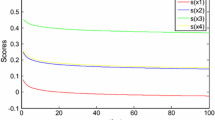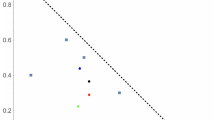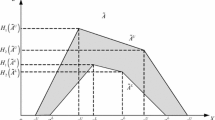Abstract
This paper describes a novel multi-attribute group decision-making (MAGDM) algorithm based on complex intuitionistic fuzzy values (CIFVs). The present work is divided into three parts. In the first part, the uncertainties in the data are expressed in CIFVs with two membership degrees over the unit disc of the complex plane. The second part states some new operational laws based on tangential functions and the aggregation operators to aggregate the different CIFVs. The properties related to the proposed operations and operators are studied. A nonlinear multi-objective optimization model has been formulated by considering the maximizing and minimizing satisfaction and dissatisfaction degrees respectively to derive the attribute weights for the MAGDM problems. The model has been solved using the particle swarm optimization algorithm. Finally, a numerical example illustrates a MAGDM algorithm based on proposed operators. The reliability and effectiveness of the proposed method is explored by comparing it with several general studies.


Similar content being viewed by others
References
Akram M, Peng X, Sattar A (2021) A new decision-making model using complex intuitionistic fuzzy Hamacher aggregation operators. Soft Comput 25:7059–7086
Ali R, Abdullah S, Muhammad S, Naeem M, Chinram R (2021) Complex intuitionistic fuzzy Maclaurin symmetric mean operators and its application to emergency program selection. J Intell Fuzzy Syst 41(1):517–538
Ali Z, Mahmood T, Aslam M, Chinram R (2021) Another view of complex intuitionistic fuzzy soft sets based on prioritized aggregation operators and their applications to multiattribute decision making. Mathematics 9(16):1922
Alkouri AM, Salleh AR (2012) Complex intuitionistic fuzzy sets. AIP Conf Proc 1482:464–470
Alkouri AM, Salleh AR (2013) Complex atanassovs intuitionistic fuzzy relation. Abstract Appl Anal 2013 Article ID 287382, 18 pages
Alkouri AM, Salleh AR (2013) Some operations on complex atanassov’s intuitionistic fuzzy sets, In: AIP conference proceedings, vol 1571, AIP, pp 987–993
Atanassov KT (1986) Intuitionistic fuzzy sets. Fuzzy Sets Syst 20:87–96
Azam M, Ali Khan MS, Yang S (2022) A decision-making approach for the evaluation of information security management under complex intuitionistic fuzzy set environment. J Math Vol 2022:Article ID 9704466
Beliakov G, Bustince H, Goswami DP, Mukherjee UK, Pal NR (2011) On averaging operators for Atanassov’s intuitionistic fuzzy sets. Inf Sci 181:1116–1124
Chakraborty D, Guha D, Dutta B (2016) Multi-objective optimization problem under fuzzy rule constraints using particle swarm optimization. Soft Comput 20(6):2245–2259
Chen SM, Chang CH (2016) Fuzzy multiattribute decision making based on transformation techniques of intuitionistic fuzzy values and intuitionistic fuzzy geometric averaging operators. Inf Sci 352:133–149
Chen SM, Han WH (2019) Multiattribute decision making based on nonlinear programming methodology, particle swarm optimization techniques and interval-valued intuitionistic fuzzy values. Inf Sci 471:252–268
Chen SM, Huang ZC (2017) Multiattribute decision making based on interval-valued intuitionistic fuzzy values and particle swarm optimization techniques. Inf Sci 397:206–218
Das S, Guha D (2019) Attribute weight computation in a decision making problem by particle swarm optimization. Neural Comput Appl 31(7):2495–2505
Deb K (2001) Multi-objective optimization using evolutionary algorithms, vol 16. Wiley, New York
Eiben AE, Smith JE (2003) Introduction to evolutionary computing, vol 53. Springer, New York
Ejegwa PA, Agbetayo JM (2022) Similarity-distance decision-making technique and its applications via intuitionistic fuzzy pairs, Journal of Computational and Cognitive Engineering, https://doi.org/10.47852/bonviewJCCE512522514
Garg H (2016) Generalized intuitionistic fuzzy interactive geometric interaction operators using Einstein t-norm and t-conorm and their application to decision making. Comput Ind Eng 101:53–69
Garg H (2017) Novel intuitionistic fuzzy decision making method based on an improved operation laws and its application. Eng Appl Artif Intell 60:164–174
Garg H, Rani D (2019) Some generalized complex intuitionistic fuzzy aggregation operators and their application to multicriteria decision-making process. Arab J Sci Eng 44(3):2679–2698
Garg H, Rani D (2019) Exponential, logarithmic and compensative generalized aggregation operators under complex intuitionistic fuzzy environment. Group Decis Negot 28(5):991–1050
Garg H, Rani D (2020) Robust averaging-geometric aggregation operators for complex intuitionistic fuzzy sets and their applications to MCDM process. Arab J Sci Eng 45:2017–2033
Garg H, Rani D (2019) Novel exponential divergence measure of complex intuitionistic fuzzy sets with an application to decision-making process, Sci Iran 1–27
Goyal M, Yadav D, Tripathi A (2016) Intuitionistic fuzzy genetic weighted averaging operator and its application for multiple attribute decision making in E-learning. Indian J Sci Technol 9(1):1–15
He Y, Chen H, Zhou L, Liu J, Tao Z (2014) Intuitionistic fuzzy geometric interaction averaging operators and their application to multi-criteria decision making. Inf Sci 259:142–159
Huang JY (2014) Intuitionistic fuzzy hamacher aggregation operators and their application to multiple attribute decision making. J Intell Fuzzy Syst 27:505–513
Kennedy J, Eberhart R (1995) Particle swarm optimization, In: Proceedings of ICNN’95 International Conference on Neural Networks, vol. 4, IEEE, pp. 1942–1948
Khan R, Ullah K, Pamucar D, Bari M (2022) Performance measure using a multi–attribute decision making approach based on complex T-spherical fuzzy Power aggregation operators. J Comput Cogn Eng. (2021) https://doi.org/10.47852/bonviewJCCE696205514
Mahmood T, Ali Z (2021) Prioritized Muirhead mean aggregation operators under the complex single–valued neutrosophic settings and their application in multi-attribute decision making, Journal of Computational and Cognitive Engineering, https://doi.org/10.47852/bonviewJCCE2022010104
Rajareega S, Vimala J (2021) Operations on complex intuitionistic fuzzy soft lattice ordered group and CIFS-COPRAS method for equipment selection process. J Intell Fuzzy Syst 41(5):5709–5718
Ramot D, Friedman M, Langholz G, Kandel A (2003) Complex fuzzy logic. IEEE Trans Fuzzy Syst 11(4):450–461
Ramot D, Milo R, Friedman M, Kandel A (2002) Complex fuzzy sets. IEEE Trans Fuzzy Syst 10(2):171–186
Rani D, Garg H (2018) Complex intuitionistic fuzzy power aggregation operators and their applications in multicriteria decision-making. Expert Syst 35(6):e12325
Talafha M, Alkouri AU, Alqaraleh S, Zureigat H, Aljarrah A (2021) Complex hesitant fuzzy sets and its applications in multiple attributes decision-making problems. J Intell Fuzzy Syst 41(6):7299–7327
Wang W, Liu X (2012) Intuitionistic fuzzy information aggregation using Einstein operations. IEEE Trans Fuzzy Syst 20(5):923–938
Xu Z (2005) An overview of methods for determining OWA weights. Int J Intell Syst 20:843–865
Xu Z, Yager RR (2006) Some geometric aggregation operators based on intuitionistic fuzzy sets. Int J Gen Syst 35(4):417–433
Yang JM, Chen YP, Horng JT, Kao CY (1997) Applying family competition to evolution strategies for constrained optimization. In: International conference on evolutionary programming, Springer, pp 201–211
Ye J (2017) Intuitionistic fuzzy hybrid arithmetic and geometric aggregation operators for the decision-making of mechanical design schemes. Appl Intell 47:743–751
Yu W, Zhang Z, Zhong Q (2021) Consensus reaching for MAGDM with multi-granular hesitant fuzzy linguistic term sets: a minimum adjustment-based approach. Ann Oper Res 300:443–466
Zadeh LA (1965) Fuzzy sets. Inf Control 8:338–353
Zhou W, Xu Z (2017) Extreme intuitionistic fuzzy weighted aggregation operators and their applications in optimism and pessimism decision-making processes. J Intell Fuzzy Syst 32:1129–1138
Zhang Z, Yu W, Martinez L, Gao Y (2020) Managing multigranular unbalanced hesitant fuzzy linguistic information in multiattribute large-scale group decision making: A linguistic distribution-based approach. IEEE Trans Fuzzy Syst 28(11):2875–2889
Zhang Z, Kou X, Yu W, Gao Y (2021) Consistency improvement for fuzzy preference relations with self-confidence: An application in two-sided matching decision making. J Oper Res Soc 72(8):1914–1927
Zimmermann HJ (1978) Fuzzy programming and linear programming with several objective functions. Fuzzy Sets Syst 1:45–55
Acknowledgments
The author (Harish Garg) is grateful to DST-FIST grant no. SR/FST/MS-1/2017/13 for providing technical support.
Author information
Authors and Affiliations
Corresponding author
Additional information
Publisher's Note
Springer Nature remains neutral with regard to jurisdictional claims in published maps and institutional affiliations.
Appendix
Appendix
Proof of the Theorem 1:
Proof
For two CIFNs \({\mathbb {G}}_v=\left( \left( \zeta _v,w_{\zeta _v}\right) , \left( \varphi _v,w_{\varphi _v}\right) \right)\), we have \(0 \le \zeta _v, \varphi _v, w_{\zeta _v}, w_{\varphi _v}\), \(\zeta _v+\varphi _v, w_{\zeta _v}+w_{\varphi _v}\le 1\) for each \(v=1,2\). Further, assume that \({\mathbb {G}}_3={\mathbb {G}}_1 \oplus {\mathbb {G}}_2=\left( \left( \zeta _3,w_{\zeta _3}\right) , \left( \varphi _3,w_{\varphi _3}\right) \right)\).
Now, by using Definition 9, we have \(\zeta _3=\frac{2}{\pi }\tan ^{-1}\left( \sum \limits _{v=1}^2\tan \left( \frac{\pi }{2}\zeta _v\right) \right)\), \(w_{\zeta _3}=\frac{2}{\pi }\tan ^{-1}\left( \sum \limits _{v=1}^2\tan \left( \frac{\pi }{2}w_{\zeta _v}\right) \right)\), \(\varphi _3=1-\frac{2}{\pi }\tan ^{-1}\left( \sum \limits _{v=1}^2\tan \left( \frac{\pi }{2}\left( 1-\varphi _v\right) \right) \right)\) and \(w_{\varphi _3}=1-\frac{2}{\pi }\tan ^{-1}\left( \sum \limits _{v=1}^2 \tan \left( \frac{\pi }{2}\left( 1-w_{\varphi _v}\right) \right) \right)\). To prove \({\mathbb {G}}_3\) is CIFN, it is sufficient to show that \(0 \le \zeta _3,w_{\zeta _3},\varphi _3,w_{\varphi _3} \le 1\) such that \(0 \le \zeta _3+w_{\zeta _3}, \varphi _3+w_{\varphi _3} \le 1\). Now, since \(0 \le \zeta _v \le 1\) for each \(v=1,2\). It implies that \(0 \le \frac{\pi }{2}\zeta _v \le \frac{\pi }{2}\) which gives that \(\sum \limits _{v=1}^2\tan \left( \frac{\pi }{2}\zeta _v\right)\) always takes non-negative value. Also, we know that the principal value branch of \(\tan ^{-1}(x)\) is \(\left[ \frac{-\pi }{2},\frac{\pi }{2}\right]\) for every number x belonging to the extended real system. But since, \(\sum \limits _{v=1}^2\tan \left( \frac{\pi }{2}\zeta _v\right)\) is always non-negative therefore, \(0 \le \tan ^{-1}\left( \sum \limits _{v=1}^2 \tan \left( \frac{\pi }{2}\zeta _v\right) \right) \le \frac{\pi }{2}\) which gives that \(0 \le \frac{2}{\pi }\tan ^{-1}\left( \sum \limits _{v=1}^2\tan \left( \frac{\pi }{2}\zeta _v\right) \right) \le 1\). Hence, \(0 \le \zeta _3 \le 1\). Similarly, it can be obtained that \(0 \le w_{\zeta _3}, \varphi _3,w_{\varphi _3} \le 1\). Further, using the facts that \(\tan (x)\), \(\tan ^{-1}(x)\) are increasing functions and \(0 \le \zeta _v+\varphi _v \le 1\) for each \(v=1,2\), we obtain that
Also, since \(\zeta _3, \varphi _3 \ge 0\) therefore, \(\zeta _3+\varphi _3 \ge 0\). Hence, we obtain that \(0 \le \zeta _3+\varphi _3 \le 1\). Similarly, it can be proved that \(0 \le w_{\zeta _3}+w_{\varphi _3} \le 1\). Hence, \({\mathbb {G}}_3 ={\mathbb {G}}_1 \oplus {\mathbb {G}}_2\) is a CIFN. In the same way, \({\mathbb {G}}_1 \otimes {\mathbb {G}}_2\) is also CIFN. \(\square\)
Proof of the Theorem 2:
Proof
Hence, \(({\mathbb {G}}_1 \oplus {\mathbb {G}}_2)^c={\mathbb {G}}_1^c \otimes {\mathbb {G}}_2^c\). \(\square\)
Proof of the Theorem 5:
Proof
Let \({\mathbb {G}}_v=(\left( \zeta _{G_v},w_{\zeta _{G_v}}\right)\), \(\left( \varphi _{G_v},w_{\varphi _{G_v}}\right) )\) and \({\mathbb {H}}_v=\left( \left( \zeta _{H_v},w_{\zeta _{H_v}}\right) , \left( \varphi _{H_v},w_{\varphi _{H_v}}\right) \right)\). Further, assume that \({\mathbb {G}}_1 \oplus {\mathbb {G}}_2=(\left( \zeta _{G},w_{\zeta _{G}}\right)\), \(\left( \varphi _{G},w_{\varphi _{G}}\right) )\) and \({\mathbb {H}}_1 \oplus {\mathbb {H}}_2=\left( \left( \zeta _{H},w_{\zeta _{H}}\right) , \left( \varphi _{H},w_{\varphi _{H}}\right) \right)\). Since, \({\mathbb {G}}_v \subseteq {\mathbb {H}}_v\). Therefore, by using Definition 5, we obtain that \(\zeta _{G_v} \le \zeta _{H_v}\), \(w_{\zeta _{G_v}} \le w_{\zeta _{H_v}}\), \(\varphi _{G_v} \ge \varphi _{H_v}\) and \(w_{\varphi _{G_v}} \ge w_{\varphi _{H_v}}\) for each \(v=1,2\). Since, \(\zeta _{G_v} \le \zeta _{H_v} \Rightarrow \frac{\pi }{2}\zeta _{G_v} \le \frac{\pi }{2}\zeta _{H_v} \Rightarrow \tan \left( \frac{\pi }{2}\zeta _{G_v}\right) \le \tan \left( \frac{\pi }{2}\zeta _{H_v}\right) \Rightarrow \frac{2}{\pi }\tan ^{-1}\left( \sum \limits _{v=1}^2\tan \left( \frac{\pi }{2}\zeta _{G_v}\right) \right) \le \frac{2}{\pi }\tan ^{-1}\left( \sum \limits _{v=1}^2\tan \left( \frac{\pi }{2}\zeta _{H_v}\right) \right) \Rightarrow \zeta _G \le \zeta _H\). Also, we have \(\varphi _{G_v} \ge \varphi _{H_v} \Rightarrow 1-\varphi _{G_v} \le 1-\varphi _{H_v} \Rightarrow \frac{\pi }{2}\left( 1-\varphi _{G_v}\right) \le \frac{\pi }{2}\left( 1-\varphi _{H_v}\right) \Rightarrow \tan \left( \frac{\pi }{2}\left( 1-\varphi _{G_v}\right) \right) \le \tan \left( \frac{\pi }{2}\left( 1-\varphi _{H_v}\right) \right) \Rightarrow \sum \limits _{v=1}^2\tan \left( \frac{\pi }{2} \left( 1-\varphi _{G_v}\right) \right) \le \sum \limits _{v=1}^2 \tan \left( \frac{\pi }{2}\left( 1-\varphi _{H_v}\right) \right) \Rightarrow 1-\frac{2}{\pi }\tan ^{-1}\left( \sum \limits _{v=1}^2 \tan \left( \frac{\pi }{2}\left( 1-\varphi _{G_v}\right) \right) \right) \ge 1-\frac{2}{\pi }\tan ^{-1}\left( \sum \limits _{v=1}^2\tan \left( \frac{\pi }{2}\left( 1-\varphi _{H_v}\right) \right) \right) \Rightarrow \varphi _{G} \ge \varphi _{H}\). In the similar manner, we can prove that \(w_{\zeta _G} \le w_{\zeta _H}\) and \(w_{\varphi _{G}} \ge w_{\varphi _{H}}\). Hence, by using Definition 5, we have \({\mathbb {G}}_1 \oplus {\mathbb {G}}_2 \subseteq {\mathbb {H}}_1 \oplus {\mathbb {H}}_2\). \(\square\)
Proof of the Theorem 6:
Proof
We apply induction principle on \(\rho\) to prove Eq. (5).
- Step 1::
-
For \(\rho =2\),
$$\begin{aligned}&{\mathbb {G}}_1 \oplus {\mathbb {G}}_1 \\&\quad = \left( \begin{aligned}\left( \begin{aligned}&\frac{2}{\pi }\tan ^{-1}\left( \sum \limits _{v=1}^2\tan \left( \frac{\pi }{2}\zeta _1\right) \right) , \\&\frac{2}{\pi }\tan ^{-1}\left( \sum \limits _{v=1}^2\tan \left( \frac{\pi }{2}w_{\zeta _1}\right) \right) \end{aligned}\right) , \left( \begin{aligned}&1-\frac{2}{\pi }\tan ^{-1}\left( \sum \limits _{v=1}^2\tan \left( \frac{\pi }{2}\left( 1-\varphi _1\right) \right) \right) , \\&1-\frac{2}{\pi }\tan ^{-1}\left( \sum \limits _{v=1}^2\tan \left( \frac{\pi }{2}\left( 1-w_{\varphi _1}\right) \right) \right) \end{aligned}\right) \end{aligned}\right) \\&\quad =\left( \begin{aligned}\left( \begin{aligned}&\frac{2}{\pi }\tan ^{-1}\left( 2\tan \left( \frac{\pi }{2}\zeta _1\right) \right) , \\&\frac{2}{\pi }\tan ^{-1}\left( 2\tan \left( \frac{\pi }{2}w_{\zeta _1}\right) \right) \end{aligned}\right) , \left( \begin{aligned}&1-\frac{2}{\pi }\tan ^{-1}\left( 2\tan \left( \frac{\pi }{2}\left( 1-\varphi _1\right) \right) \right) , \\&1-\frac{2}{\pi }\tan ^{-1}\left( 2\tan \left( \frac{\pi }{2}\left( 1-w_{\varphi _1}\right) \right) \right) \end{aligned}\right) \end{aligned}\right) \end{aligned}$$Hence, the Eq. (5) is true for \(\rho =2\).
- Step 2::
-
Assume Eq. (5) true for \(\rho =\rho _0\). Then,
$$\begin{aligned}&(\rho _0+1){\mathbb {G}}_1\\&\quad =\underbrace{{\mathbb {G}}_1\oplus {\mathbb {G}}_1\oplus \ldots \oplus {\mathbb {G}}_1}_{(\rho _0+1) \,\text {times}} \\&\quad = \left( \underbrace{{\mathbb {G}}_1\oplus {\mathbb {G}}_1\oplus \ldots \oplus {\mathbb {G}}_1}_{(\rho _0) \,\text {times}}\right) \oplus {\mathbb {G}}_1 \\&\quad =\left( \begin{aligned}\left( \begin{aligned}&\frac{2}{\pi }\tan ^{-1}\left( \rho _0\tan \left( \frac{\pi }{2}\zeta _1\right) \right) , \\&\frac{2}{\pi }\tan ^{-1}\left( \rho _0\tan \left( \frac{\pi }{2}w_{\zeta _1}\right) \right) \end{aligned}\right) , \left( \begin{aligned}&1-\frac{2}{\pi }\tan ^{-1}\left( \rho _0\tan \left( \frac{\pi }{2}\left( 1-\varphi _1\right) \right) \right) , \\&1-\frac{2}{\pi }\tan ^{-1}\left( \rho _0\tan \left( \frac{\pi }{2}\left( 1-w_{\varphi _1}\right) \right) \right) \end{aligned}\right) \end{aligned}\right) \\&\qquad \oplus \left( \left( \zeta _{1},w_{\zeta _{1}}\right) ,\left( \varphi _{1},w_{\varphi _{1}}\right) \right) \\&\quad =\left( \begin{aligned}\left( \begin{aligned}&\frac{2}{\pi }\tan ^{-1}\left( \rho _0\tan \left( \frac{\pi }{2}\zeta _1\right) +\tan \left( \frac{\pi }{2}\zeta _1\right) \right) ,\\&\frac{2}{\pi }\tan ^{-1}\left( \rho _0\tan \left( \frac{\pi }{2}w_{\zeta _1}\right) +\tan \left( \frac{\pi }{2}w_{\zeta _1}\right) \right) \\ \end{aligned}\right) , \\ \left( \begin{aligned}&1-\frac{2}{\pi }\tan ^{-1}\left( \rho _0\tan \left( \frac{\pi }{2}\left( 1-\varphi _1\right) \right) +\tan \left( \frac{\pi }{2}\left( 1-\varphi _1\right) \right) \right) ,\\&1-\frac{2}{\pi }\tan ^{-1}\left( \rho _0\tan \left( \frac{\pi }{2}\left( 1-w_{\varphi _1}\right) \right) +\tan \left( \frac{\pi }{2}\left( 1-w_{\varphi _1}\right) \right) \right) \\ \end{aligned}\right) \end{aligned}\right) \\&\quad =\left( \begin{aligned}\left( \begin{aligned}&\frac{2}{\pi }\tan ^{-1}\left( (\rho _0+1)\tan \left( \frac{\pi }{2}\zeta _1\right) \right) ,\\&\frac{2}{\pi }\tan ^{-1}\left( (\rho _0+1)\tan \left( \frac{\pi }{2}w_{\zeta _1}\right) \right) \\ \end{aligned}\right) , \left( \begin{aligned}&1-\frac{2}{\pi }\tan ^{-1}\left( (\rho _0+1)\tan \left( \frac{\pi }{2}\left( 1-\varphi _1\right) \right) \right) ,\\&1-\frac{2}{\pi }\tan ^{-1}\left( (\rho _0+1)\tan \left( \frac{\pi }{2}\left( 1-w_{\varphi _1}\right) \right) \right) \\ \end{aligned}\right) \end{aligned}\right) \end{aligned}$$Thus, the Eq. (5) is true for \(\rho =\rho _0+1\). Hence, by principle of mathematical induction, the Eq. (5) holds for all natural numbers \(\rho\).
\(\square\)
Proof of the Theorem 9:
Proof
Hence, \(\left( {\mathbb {G}}_1^c\right) ^{\rho }=\left( \rho {\mathbb {G}}_1\right) ^c\). \(\square\)
Proof of the Theorem 10:
Proof
Hence, \(\rho \left( {\mathbb {G}}_1 \oplus {\mathbb {G}}_2\right) =\rho {\mathbb {G}}_1 \oplus \rho {\mathbb {G}}_2\). \(\square\)
Proof of the Theorem 11:
Proof
Take \(c(x,y)=\frac{2}{\pi }\tan ^{-1}\left( x\tan \left( \frac{\pi }{2}y\right) \right)\) and \(d(x,y)=1-\frac{2}{\pi }\tan ^{-1}\left( x\tan \left( \frac{\pi }{2}(1-y)\right) \right)\) for \(x>0\) and \(0 \le y \le 1\). Thus,
which implies that the function “c” is increasing while “d” is increasing with y and decreasing with x.
Consider two CIFNs \({\mathbb {G}}_v=\left( \left( \zeta _{v},w_{\zeta _{v}}\right) , \left( \varphi _{v},w_{\varphi _{v}}\right) \right)\) (\(v=1,2\)) such that \(\zeta _1 \le \zeta _2\), \(w_{\zeta _1} \le w_{\zeta _2}\), \(\varphi _1 \ge \varphi _2\) and \(w_{\varphi _1} \ge w_{\varphi _2}\), i.e., \({\mathbb {G}}_1 \subseteq {\mathbb {G}}_2\). Now
It implies that \(\rho {\mathbb {G}}_1 \subseteq \rho {\mathbb {G}}_2\). Similarly, it can be obtained that \({\mathbb {G}}_1^\rho \subseteq {\mathbb {G}}_2^\rho\) when \({\mathbb {G}}_1 \subseteq {\mathbb {G}}_2\).
Next, for two reals \(\rho _1\) and \(\rho _2\) such that \(0<\rho _1\le \rho _2\), we have
It gives that \(\rho _1{\mathbb {G}}_1 \subseteq \rho _2{\mathbb {G}}_1\). Similarly, \({\mathbb {G}}_1^{\rho _2} \subseteq {\mathbb {G}}_1^{\rho _1}\) when \(\rho _1 \le \rho _2\).
Hence, the result. \(\square\)
Proof of the Property 1:
Proof
Let \({\mathbb {G}}_0=\left( \left( \zeta _0,w_{\zeta _0}\right) , \left( \varphi _0,w_{\varphi _0}\right) \right)\). Since, \({\mathbb {G}}_v={\mathbb {G}}_0 \forall v\). It implies that \(\zeta _v=\zeta _0\), \(w_{\zeta _v}=w_{\zeta _0}\), \(\varphi _v=\varphi _0\) and \(w_{\varphi _v}=w_{\varphi _0} \forall v\). Further, using the fact that \(\sum \limits _{v=1}^n \psi _v=1\) and Eq. (8), we have
Hence, \(\text {CIFWA}({\mathbb {G}}_1, {\mathbb {G}}_2 \ldots {\mathbb {G}}_n)= {\mathbb {G}}_0\). \(\square\)
Proof of the Property 2:
Proof
Since, \({\mathbb {G}}_v \subseteq {\mathbb {H}}_v\) for each v. Then, by Theorem 5, \(\psi _1{\mathbb {G}}_1 \oplus \psi _2{\mathbb {G}}_2 \oplus \ldots \oplus \psi _n{\mathbb {G}}_n \subseteq \psi _1{\mathbb {H}}_1 \oplus \psi _2{\mathbb {H}}_2 \oplus \ldots \oplus \psi _n{\mathbb {H}}_n\). Hence, \(\text {CIFWA}({\mathbb {G}}_1,{\mathbb {G}}_2,\ldots ,{\mathbb {G}}_n) \subseteq \text {CIFWA}({\mathbb {H}}_1,{\mathbb {H}}_2, \ldots , {\mathbb {H}}_n)\). \(\square\)
Proof of the Property 3:
Proof
Since, \({\mathbb {G}}^- \subseteq {\mathbb {G}}_v \subseteq {\mathbb {G}}^+ \forall v\), so by Property 2, \(\text {CIFWA}({\mathbb {G}}^-, {\mathbb {G}}^-\), \(\ldots\), \({\mathbb {G}}^-) \subseteq \text {CIFWA}({\mathbb {G}}_1\), \({\mathbb {G}}_2, \ldots , {\mathbb {G}}_n) \subseteq \text {CIFWA}({\mathbb {G}}^+, {\mathbb {G}}^+, \ldots , {\mathbb {G}}^+)\). Further, by using Property 1, we obtain that \({\mathbb {G}}^- \subseteq \text {CIFWA}({\mathbb {G}}_1, {\mathbb {G}}_2 \ldots {\mathbb {G}}_n) \subseteq {\mathbb {G}}^+\), which completes the proof. \(\square\)
Rights and permissions
About this article
Cite this article
Rani, D., Garg, H. Multiple attributes group decision-making based on trigonometric operators, particle swarm optimization and complex intuitionistic fuzzy values. Artif Intell Rev 56, 1787–1831 (2023). https://doi.org/10.1007/s10462-022-10208-2
Published:
Issue Date:
DOI: https://doi.org/10.1007/s10462-022-10208-2




